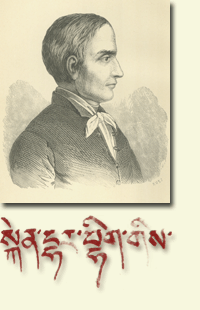|
The Csoma Collection, one of the many famous and valuable collections conserved in the Library of the Hungarian Academy of Sciences, consists of nearly forty volumes in the Tibetan language. These books were donated in 1839 by Csoma to the secretary of the Asiatic Society of Bengal S. C. Malan, to whom he taught the Tibetan language at that time. As this was a private donation, nobody knew about these books until Tivadar Duka, the biographer of Csoma, visited Malan in London in 1883. Malan – either at the request of Duka, or out of reverence to the memory of Csoma – gave these books to Duka, who donated them in 1885 to the Hungarian Academy of Sciences. The 36 items of this collection can be divided into two main parts: the so-called ‘Alexander Books’ on the one hand, and the prints and manuscripts copied or purchased by Csoma on the other. The Alexander Books The ‘Alexander Books’ are summary outlines of various fields of Tibetan literature and scholarship, compiled by Csoma’s teachers at his explicit request. They address his questions about Tibetan culture and religion. Csoma probably had them composed during his first study trip to Zangla. As the books are mostly excerpts of larger, well known works, they add very little to Tibetan studies. The lamas who compiled them even expressed their indignation at the task, calling these texts in the colophons “idle writings” that “bear no refreshment to the soul”, and “neither can they expect fame or admiration”. Their value resides in their uniqueness, having been composed personally for Csoma. Therefore we can regard them as sources that chronicle some important moments of his life and work. The Oriental Collection of the Library of the Hungarian Academy of Sciences conserves the following “Alexander Books”: 1. [inv. no.: Csoma No. 3] [inv. no.: Csoma No. 3] “A Ship Sailing on the Sea of (different) Philosophical Systems – Questions and Answers” (dris lan grub mtha’i rgya mtshor ’djug pa’i gru gzings). Although this title might induce us to think that this book belongs to the well known Tibetan genre of grub mtha’, discussing the differences of Buddhist and non-Buddhist philosophical schools, in reality it is a uniquely original work, containing Csoma’s questions about Tibetan culture and religion, and the answers he provides. They include questions like “What does the word Buddha mean?” “Were linguistics, logics, art, medicine etc. invented in Tibet, or did they originate in other lands?” “Why are the heretical sects incompatible with the teaching of the Buddha?” This work was compiled by Tsul-khrims Rgya-mcho in 1824. 2. [inv. no.: Csoma No. 4a-d] Its title, as written in the colophon: “Answers to the Questions of Sken dha (=Skander, that is, Sándor) from India-Rum (=Roman, that is, European)” (rgya gar rum yul pa sken dhas dris lan). Like the previous book, this one also contains the answers to various questions, like “How did the world came into existence?”, “What do the ‘Three Treasures’ mean?”, “How did the sutras and tantras spread all over India and Tibet?” The author of the book was Kun-dga’ Chos-legs, a relative of Csoma’s main teacher Sangs-rgyas Phun-tshogs, abbot of the monastery of Rdzong-khul. The text was most probably composed around 1823-24. 3. [inv. no.: Csoma No. 6a-b] This volume contains two autonomous works, marked with a and b, devoted to two different fields that are, however, closely related to each other in Tibetan scholarship: medicine and astronomy. The title of the first one is “Eight-Folded Medicine, or Comments to the Four Tantras” (gso dpyad yan lag brgyad pa rgyud bzhi’i bsdoms tshigs bkod pa). This is a short summary of the history and contents of the Four Tantras (Rgyud bzhi), the fundamental work of Tibetan medicine. The other work, with the title “Explanation of Chronology” (Rtsis kyi bstan bchos) summarizes the history and system of astronomy and astrology, and it was prepared, according to its colophon “on the request of Sken-dhar-bhig (=Skander beg, that is, Master Sándor) of Rum(=European, rum pa), by the monk of Zangskar Sangs-rgyas Phun-tshogs”. 4. [inv. no.: Csoma No. 8] This work has neither a title, nor a colophon. It simply mentions in the first few lines, as if announcing its content, that it will discuss grammar (sgra), poetry (snyan ngag) and metrics (sdeb sbyor). In addition, it offers a short summary of the “science” of metaphor (mngon brdzhod) and drama (zlos gar), as well as of the most important works dealing with them. The author of this book is Sangs-rgyas Phun-tshogs.
|






